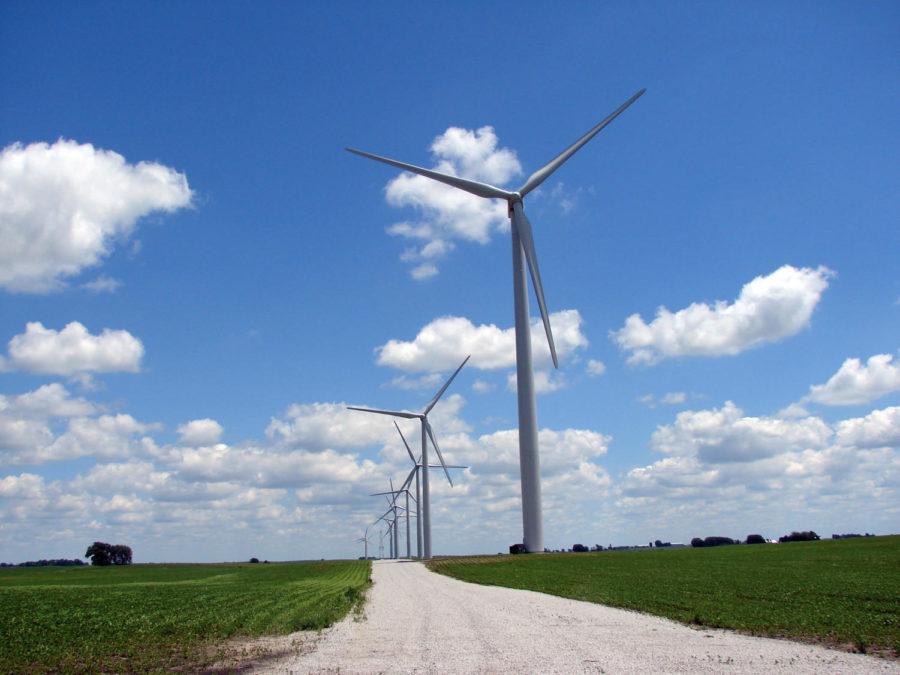Ellingson: Renewable energy is essential
Photo courtesy of Flickr/jenpilot
Fossil fuels leave pollutants that can be carried to different geographical locations and their costs are rising. Wind is a renewable energy source that can possibly replace harmful fossil fuels. Iowa State is investing in wind energy with a wind turbine on the east side of campus.
January 29, 2013
In a world full of technological advancements and exponentially growing populations, it’s no wonder the planet’s nonrenewable resources are being depleted at an alarming rate. This is especially true in the United States, where we consume at least 20 percent of the world’s total energy resources. Keep in mind, we only make up 5 percent of the entire world’s population, yet as a whole we use up so much more energy than necessary without thinking much about it.
To put it in a more straightforward perspective: Americans consume about four times more resources than necessary, significantly limiting the resources available to those in other countries. Several developing countries do not even have access to clean drinking water, let alone many other resources which we take for granted with our lavish lifestyles.
Fossil fuels (such as coal, oil and natural gas) are currently the most commonly used sources of energy, despite the fact that they are far more harmful to the environment than several other sources. They are a nonpoint source of pollution (runoff that moves through the ground via rainfall and snowmelt which carries pollutants into various bodies of water) and a major contributor to greenhouse gas emissions.
As hopefully all of you have noticed by now, there has been a significant spike in gas prices over this decade, and if we continue to rely on fossil fuels for every aspect of our energy use, the cost of gas will continue to climb. Eventually, the cost of retrieving fossil fuels will probably be too expensive for many of us to buy due to the rapid rate in which we’re using it; Provided we do not run out of these finite sources completely.
There have been success stories about vehicles powered by fuels such as water and electricity, but they are uncommon and have yet to be fully developed. In addition, the average American simply cannot afford to trade their current gas-guzzling cars for new energy efficient ones. For now, the limited resources necessary to power our vehicles should be used wisely and for things which do not have a decent alternative source of power available.
Luckily, over the years people have been coming up with new and exciting ways to harness renewable energy that is friendlier to humans and ecosystems alike.
One method, which has been a popular topic in the Iowa State news lately, is wind energy. As many of you have seen, a new, small wind turbine has been set up on the east side of campus. This project cost $250,000, but it can create enough electricity to power buildings like Catt Hall and East Hall for an entire year. In statistical terms, it can generate up to $18,000 (.12 percent) worth of Iowa State’s electrical needs annually, which is about 183,330-kilowatt hours. Iowa State also has partial ownership of a large wind turbine farm in northern Story County.
In Iowa, wind turbine farms have been increasing in popularity over the years and produce approximately twenty percent of the state’s electricity. There are nearly 3,000 utility-scale turbines in the state; enough to power over one million homes. Iowa is also rated No. 1 in wind energy related employment in the nation by offering at least 3,000 jobs, if not more.
Best of all, aside from the start up costs, wind energy is renewable and has less hazardous effects on the environment. There are several other types of similar renewable energy resources that would be better alternatives to fossil fuels, such as solar energy, hydropower and biomass energy. In addition, there are a few energy sources that have the potential to be useful but are not very cost-effective or easily acquired right now, such as geothermal energy, hydrogen and ocean energy.
Overall, it is in everyone’s best interest to be conscious of the energy they consume and where it comes from. Developing awareness of renewable energy is essential. If the human species continues on the current trajectory of heavy fossil fuel usage, the impacts it will have on our lives and the environment could be devastating in the near future.
——————————————————————————————-
Caitlin Ellingson is a junior in journalism and mass communication and environmental studies from Milo, Iowa.







